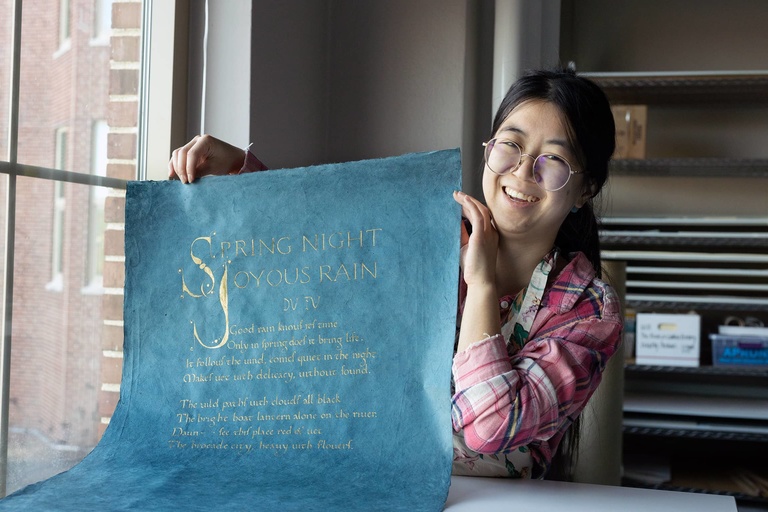On a late evening in the University of Iowa’s North Hall, students quietly stoop over long tables draped with large sheets of paper. Slow, methodical strokes of brown walnut ink transfer from brush to paper to form classic Roman letters, while a large chalkboard at the front of the room demonstrates proper forms, each one flocked by small annotations of the various angles.
Cheryl Jacobsen, an adjunct assistant professor in Calligraphy and Letter Arts, has taught calligraphy at the University of Iowa Center for the Book (UICB) for over 30 years. She’s grateful UICB provides the time and space to deliver her broad knowledge to a variety of young students.
“It's so inspiring, and I love the interdisciplinary sort of things I get to do with graphic designers, medieval studies, fine artists, and even football players,” she exclaims. “I get a whole range of people, and it's fun to watch how everybody gets together and use what I've got.”

Jacobsen, who also freelances out of her home studio, says UICB’s calligraphy program has evolved over the years beyond just studying historical methods, such as applying those methods within other artistic forms and disciplines, as well as working with writers, librarians, paleographers, and scholars of medieval studies.
“It’s just so much more interdisciplinary now, and there are so many different tendrils that reach out from the Center,” she notes.
Lessons in traditional lettering have proven an enriching part of the graduate experience for many students enrolled at the Center for the Book, including Louisa Eastley.
“I love calligraphy because it is very human. I love that every stroke is an opportunity for the artist or for the scribe to create something very individual,” says Eastley, a current MFA candidate in Historical Book Binding. “I think that these days we've forgotten how much effort was put into every word that was in an old manuscript, and that calligraphy is a way to reclaim some of that history and to be able to better understand the ways that things are made historically,” she adds.

Eastley currently focuses on book structures and hopes to work as a conservator specializing in artifacts from the 14th and 15th centuries.
“The calligraphy aspect is partially, for me, an artistic choice, but it's also a paleographical pursuit, whereby being able to know how to make the letters themselves, I'm better able to read them and to see the ways in which the scribes of the day were attempting to work,” she explains.
Standout projects from Eastley’s calligraphy studies include an illustrated rendition of "I Sit Beside the Fire and Think," a poem by J. R. R. Tolkien; and a booklet presentation of "The Starlight Night" by Victorian poet Gerard Manley Hopkins.
“It's exciting to be able to look at old documents and old methods and then to try to recreate them myself,” she notes. “I've discovered that, as I've learned how to make the different scripts myself, that I've been better able to read documents in other classes and that I've felt more of a connection to the old artists.”
Clara Ng, who received a Master of Arts in Book Studies and Library and Information Science Studies in 2023, as well as a Certificate in Book Arts, has fond memories studying under the tutelage of Jacobsen.

“Having been in several of her classes, she's very encouraging. She'll always be very supportive of what you're doing,” Ng insists. “She's really good at finding where your strengths are, what you're improving the most on, and what you could work on.”
Ng notes that, although one can easily feel discouraged when starting calligraphy, she found the practice creatively fulfilling and celebratory of the artform’s synergetic nature.
“Calligraphy was one of the areas where I felt that I could see the most progression,” she cites. “Thinking about the way that like typography or typefaces have developed from hands, and how hands have then taken back from typefaces in the way that there's an intertextual relationship between the two is really cool to me, historically and artistically.”
Highlights from Ng’s calligraphy studies include her rendition of “Spring Night Joyous Rain” by Chinese poet Du Fu, and a five-foot-long rendition of "The Táin," also known as "The Cattle Raid of Cooley," an epic poem from Irish mythology.
“I really appreciate that the UICB has a really solid foundation in craft, and we're really focused on producing work that is up to a specific standard,” Ng adds.
The school’s calligraphy courses feature emphasis on Roman letterforms, blackletter hands, history of Western letterforms, and layout and color theory. Louisa says the classes revolve around communication, practice, and refining technique over time.
“The vast majority of the time is simply spent attempting to create the letters the way that they ought to be, and then getting feedback from her on what we can do to improve,” she cites.
“It's a real slowing down, and it becomes almost meditative in a way,” Jacobsen explains. “That's nice once you get past the frustration. You can get really lost in it and lose yourself in that sort of flow state.”
The adjunct professor says her students have gone on to incorporate the skills and knowledge gained into a variety of fields.
“One of the amazing things is watching people go from often never even thinking about calligraphy to really getting into it, taking everything they've learned here, and making their own business out of it,” she reflects. “Watching them flourish in the calligraphy world is wonderful.”

| 
|